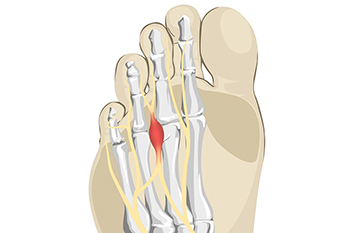Why Does Morton’s Neuroma Develop?
Tuesday, 01 November 2022 00:00
Nerve tissue between the third and fourth toes that becomes thick, or compressed, may indicate a condition known as Morton’s neuroma. It happens when there is not enough room for the toes to move freely in from wearing certain types of shoes. High heels fall into this category, and may cause the nerve to become irritated and inflamed. It is considered to be a painful foot condition, and relief may be found when different shoes are worn. This may be a successful treatment method if it is noticed early, and completing daily activities with ease may resume. In severe cases, where walking becomes difficult, surgery may be a necessary option for permanent relief by removing the affected nerve. The symptoms that many people can experience with this condition include the sensation of standing on a pebble or marble, and pain may radiate from the ball of the foot. Morton’s neuroma is a serious foot condition, and if you have any of the above symptoms, it is strongly advised that you are under the care of a podiatrist who can help you to find permanent relief.
Morton’s neuroma is a very uncomfortable condition to live with. If you think you have Morton’s neuroma, contact Dawn Miles, DPM of Florida. Our doctor will attend to all of your foot care needs and answer any of your related questions.
Morton’s Neuroma
Morton's neuroma is a painful foot condition that commonly affects the areas between the second and third or third and fourth toe, although other areas of the foot are also susceptible. Morton’s neuroma is caused by an inflamed nerve in the foot that is being squeezed and aggravated by surrounding bones.
What Increases the Chances of Having Morton’s Neuroma?
- Ill-fitting high heels or shoes that add pressure to the toe or foot
- Jogging, running or any sport that involves constant impact to the foot
- Flat feet, bunions, and any other foot deformities
Morton’s neuroma is a very treatable condition. Orthotics and shoe inserts can often be used to alleviate the pain on the forefront of the feet. In more severe cases, corticosteroids can also be prescribed. In order to figure out the best treatment for your neuroma, it’s recommended to seek the care of a podiatrist who can diagnose your condition and provide different treatment options.
If you have any questions, please feel free to contact one of our offices located in Palatka and Saint Augustine, FL . We offer the newest diagnostic and treatment technologies for all your foot care needs.









